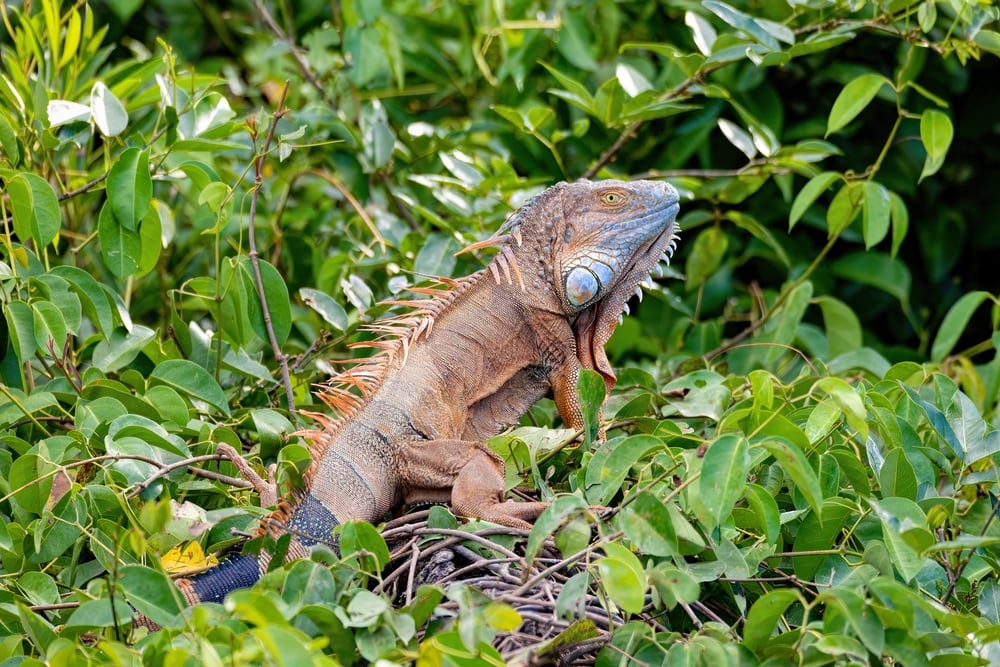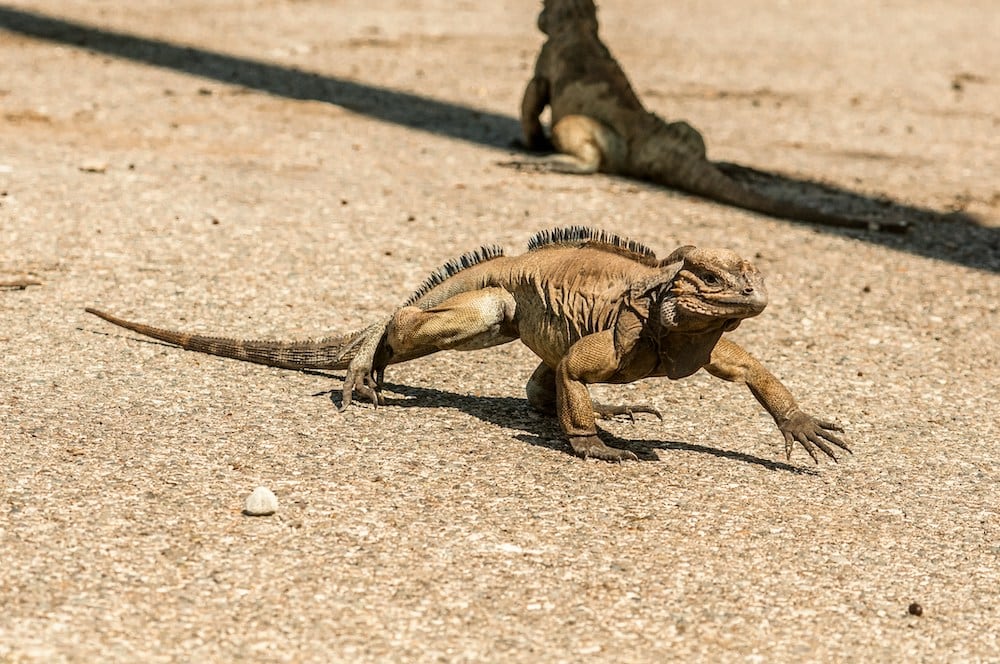Iguanas are fascinating creatures with a surprising ability to move quickly when needed, which is especially concerning considering iguanas may attack. You might be taken aback to learn that they can reach speeds that would challenge even some of the fastest sprinters in the animal kingdom. A healthy iguana can sprint up to 21 miles per hour, making them exceptionally swift for their size.
This impressive speed aids iguanas in evading predators and navigating their environments. The Spiny-Tailed Iguana, for example, is known for its quick speed and agility, which it employs to escape threats and hunt. Each iguana species may exhibit slight variations in their top speeds, influenced by factors like health, age, and environmental conditions.
Understanding these speed capabilities not only deepens the appreciation for these reptiles but also highlights their adaptability and survival strategies in the wild. Check out more about their agility and what influences their rapid movements on sites such as Berry Patch Farms and TRVST.
Iguana Basics
Iguanas are fascinating reptiles with specific needs and behaviors. They thrive in particular habitats and have distinct dietary habits which influence their overall health and activity levels.
Habitat Preferences
All iguana types are typically found in warmer climates, most notably in Central and South America. These reptiles also inhabit various Caribbean islands. In Florida, they have become an invasive species, thriving in tropical and subtropical areas due to the warm temperatures and abundant foliage.
They prefer environments with plenty of vegetation, such as forests and near water sources like rivers or lakes. This is because they rely on foliage for food and cover. In urban areas, iguanas might take refuge in gardens, parks, and even attics or roofs, mimicking their natural tree-dwelling behaviors.
Diet and Behavior
Iguanas are primarily herbivores, feeding on a diet rich in leafy greens, fruits, and flowers. Common food items include lettuce, spinach, and mangos. Occasionally, they may consume insects or small animals, but this is rare.
Their behavior is largely influenced by temperature. They are diurnal, actively foraging during the day and resting at night. Iguanas are also adept climbers and swimmers, skills that help them escape predators or search for food. In Florida, where they are an invasive species, this adaptability has allowed them to thrive, often at the expense of native wildlife and plant species.
Top Speed and Locomotion
Iguanas can achieve notable speeds due to their strong limbs and agile movements. Various factors like health, temperature, and species impact their running capability.
Factors Influencing Speed
Several elements affect an iguana’s speed. Healthy iguanas generally run faster than ill or injured ones. Temperature plays a critical role; colder weather tends to decrease their agility. In optimal conditions, a young iguana, around 1-2 feet in length, can sprint up to 15 miles per hour.
Age, size, and species also make a difference. Green iguanas, known for their agility, can reach impressive speeds. Larger iguanas may be slower, but their powerful muscles still allow bursts of quick movement to escape predators.
Comparing Speeds: Iguanas vs. Other Reptiles
When comparing iguanas to other reptiles, they hold their own quite well. While iguanas can hit up to 25 miles per hour, some reptiles like the black spiny-tailed iguana can run even faster. Still, this pales in comparison to species such as the cheetah, known for speeds over 60 mph.
Iguanas rely more on quick sprints than sustained running, using their speed to evade threats and navigate their environments efficiently. Their ability to combine swift bursts with swimming makes them versatile movers in both terrestrial and aquatic settings.
Environmental and Ecological Impact
The introduction of iguanas into non-native environments has led to significant ecological changes. Because they are an invasive species, their presence can disrupt local species and alter the balance of ecosystems.
Impact of Invasive Species
Iguanas are invasive in various parts of the world, particularly in Florida. They thrive in these environments due to a lack of natural predators and an abundant food supply. Their rapid reproduction and growth intensify their impact.
Invasive iguanas often damage local vegetation. They consume native plants, leading to the decline of certain species. Additionally, iguanas can outcompete other herbivores for food resources, putting further stress on native fauna.
Their burrowing behavior also poses a threat. Iguanas create extensive burrow networks, which can undermine infrastructure like seawalls and levees. This behavior contributes to increased erosion and habitat destruction.
Ecosystem Balance and Iguanas
In their native habitats, iguanas play a role in seed dispersal and maintaining plant populations. However, in non-native regions, this balance can be disrupted. The consumption patterns of invasive iguanas are not aligned with the natural flora, leading to imbalances.
One of the lesser known facts about iguanas is that their presence can result in a decrease in smaller animals and insects that depend on native plant species. This ripple effect can alter food webs and ecosystem dynamics.
Furthermore, iguanas can transmit diseases to other wildlife, adding to their negative impact. Their competition for resources and alteration of habitats underscores the need for effective management to preserve ecological balance.

Human-Iguana Interactions
Human-iguana interactions often center on managing iguana populations and addressing health concerns. These interactions are crucial for maintaining ecological balance and ensuring public health and safety.
Managing Iguana Populations
In regions where iguanas are invasive, managing their populations is vital. Large numbers of iguanas can cause significant damage to local vegetation and infrastructure. As a result, communities may need to employ iguana removal services to control their numbers effectively.
Removal services often use humane traps and relocation methods to minimize harm to the iguanas. Local authorities may also implement public awareness campaigns to educate residents about proper iguana management. These efforts aim to balance preserving the species and protecting the environment.
It’s important to note the methods used by professionals are more effective and safer than attempting removal independently. Thus, relying on expert help can prevent unwanted consequences and ensure the iguanas are handled humanely.
Health Considerations
Iguanas can carry diseases that pose risks to humans, such as salmonella. Handling iguanas or coming into contact with their feces can lead to infection. Consequently, proper hygiene practices are essential, including washing hands thoroughly after interacting with iguanas.
Careful management of iguana populations also helps reduce the spread of these diseases. Ensuring iguanas are healthy can decrease the likelihood of disease transmission. Communities often work with veterinarians and wildlife experts to monitor and maintain the health of iguana populations.
Educating the public on these health risks and preventive measures is crucial. Clear guidelines can help people safely coexist with iguanas, minimizing health hazards and promoting mutual well-being.
Safety Measures
Iguanas, while generally harmless, can cause damage to gardens and property if they frequent your yard. Implementing specific measures can help maintain a safe and iguana-free environment.
Protecting Your Yard
Protecting your yard involves several targeted strategies designed to deter iguanas from entering and residing in the area. Physical barriers, such as fencing, can be highly effective. Ensure the fence is at least four feet high and has a smooth surface to prevent climbing.
Removing food sources is another crucial step. Iguanas are often attracted by fruits, vegetables, and flowers. Regularly clean up fallen fruits and secure compost bins to remove these temptations.
Another approach involves creating unfavorable conditions for iguanas. Use repellents like garlic spray or naphthalene balls to make the area less appealing. Planting iguana-resistant plants, such as rosemary or citrus, can also deter them.
Water deterrents can be an effective, humane solution. Install motion-activated sprinklers to scare away iguanas without causing harm. This solution not only deters iguanas but keeps your yard watered.
Keeping your yard free of hiding spots is important. Iguanas seek out shelter in thick bushes and piles of debris. Regularly trim overgrown vegetation and remove any unused materials that could serve as hiding places.
These combined strategies can significantly reduce the risk of iguanas becoming a problem in your yard.
Contact Iguana Control If You See Iguanas on Your Property
If you spot iguanas on your Florida property, it’s crucial to take immediate action by contacting Iguana Control. These invasive reptiles, while fascinating, can cause significant damage to your landscape, property structures, and even pose health risks. Iguanas are known for their voracious appetites, often decimating gardens and ornamental plants. They can burrow into the ground, undermining foundations, seawalls, and sidewalks, leading to costly repairs.
Moreover, iguanas can carry salmonella, a bacteria that can be transmitted to humans through contact with the reptiles or their droppings. This poses a potential health risk, especially for families with young children or pets. While it might be tempting to handle the situation on your own, iguanas can be aggressive when threatened, and improper handling can exacerbate the problem.
Iguana Control specializes in humane and effective iguana removal and management. Their team of experts is trained to identify iguana habitats, safely capture the reptiles, and implement preventive measures to keep them from returning. By contacting Iguana Control, you ensure that the issue is handled professionally, reducing the risk to yourself, your family, and your property.
Don’t let iguanas overrun your Florida property. Protect your home and garden by reaching out to Iguana Control. Their expertise and dedication to humane wildlife management make them the best choice for addressing your iguana concerns. Contact Iguana Control today for a consultation and take the first step towards a safe and iguana-free environment.


